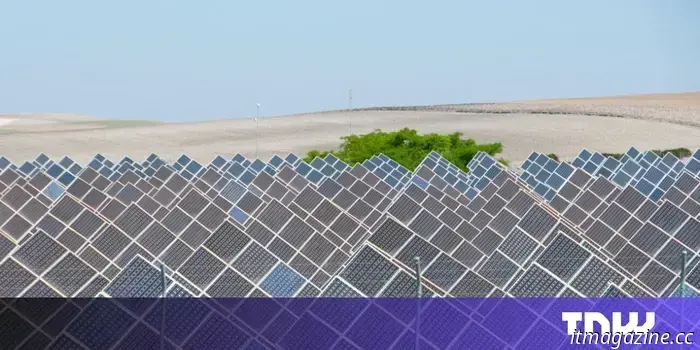
The Iberian blackout suggests challenges in the growth of green energy rather than a failure related to climate.
Spain and Portugal have mostly restored power following Monday's unprecedented blackout, the worst in recent European history. The consequences have raised questions about the region's dependence on renewable energy. Santiago Abascal, the leader of Spain's far-right Vox party, even urged the country to reject “climate fanaticism” in light of the outage. However, experts have emphasized to TNW that the issue lies not with green energy, but with the outdated grid infrastructure and technology currently in use.
“What occurred this week should serve as a clear warning about the risks of neglecting investment in a more resilient energy grid,” Taco Engelaar, managing director at energy infrastructure company Neara, told TNW from Amsterdam. Last year, Portugal and Spain obtained 87.5% and 56% of their electricity, respectively, from renewable sources such as wind, solar, and hydropower. Both nations have, at times, operated their grids solely on green energy.
“The primary point to clarify is that this is not an issue of net-zero,” Chris Glover, utilities and energy director at the British engineering consultancy Buro Happold, told TNW. “The real issue is balancing supply and demand.”
Are they exceeding grid capabilities?
Although wind and solar energy generate clean and affordable electricity, their production is not consistent — it fluctuates with weather conditions. However, the grids in Europe were predominantly designed for more stable energy sources like coal, gas, or nuclear power. Without that stabilizing factor or the integration of alternatives like battery storage systems, the grid becomes increasingly susceptible to spikes in electricity demand or supply. As observed this week, this can occasionally strain the system, leading to failures that disrupt power to homes, businesses, and essential services.
The increasing disconnect between the grid's design and its evolving energy mix is becoming evident. As the Iberian countries have advanced rapidly in adopting renewables, they risk becoming victims of their own success.
However, Glover argues that this is not a reason to slow the energy transition. Instead, he advocates for a stronger focus on energy storage, grid balancing technologies, and infrastructure improvements to create a more robust system.
‘Lacking flexibility’
Spain and Portugal are not the first to encounter such challenges. A significant blackout in 2016 left 850,000 residents of South Australia in the dark. Critics, including then-Prime Minister Malcolm Turnbull, pointed to the state's ambitious move towards renewables. Nevertheless, South Australia chose to enhance its efforts, investing in large batteries, synchronous compressors (which replicate the stabilizing “inertia” of fossil fuel turbines), and additional wind and solar power. Last year, 75% of the state's electricity came from renewables and it has not experienced another blackout since, with the International Energy Agency (IEA) describing its progress as “remarkable.”
Alex Schoch, head of flexibility at Octopus Energy, believes Spain could learn from South Australia’s achievements. While South Australia’s blackout was storm-related, he noted, “both countries’ grids were ill-equipped to handle sudden shocks.” He described Spain’s power system as one “lacking flexibility.”
Prior to the blackout, Spain’s grid was operating on nearly 80% wind and solar — a significant milestone for clean energy, but also a challenge for maintaining stability. There was minimal input from stable sources like gas or nuclear power, which are essential for keeping the grid balanced. In addition, Spain has very limited large-scale battery storage to compensate when solar or wind energy fluctuates unexpectedly.
Experts believe these conditions were crucial factors in Monday's extensive blackout. The disruption has been linked to two separate grid disconnections in the southwest of Spain — a hub for the country’s solar energy. With insufficient backup power, the system struggled to react quickly enough to these disruptions, resulting in cascading failures throughout the network.
When part of Spain's power supply dropped suddenly, the grid should have promptly reduced demand to maintain balance, such as utilizing batteries or backup systems to smooth out fluctuations, Glover explained. “It appears that no such measures were implemented,” he said.
When electricity generation dips, countries can often import power from neighboring regions. However, Spain and Portugal are largely isolated, connected only by a weak link to France through the Pyrenees mountains, rendering them more vulnerable during outages.
While the specific cause of the blackout is still being investigated, the incident — which saw Spain's grid lose 15GW of energy within just five seconds — has raised serious concerns regarding the region’s energy infrastructure and could serve as a significant warning for other nations.
The electrification dilemma
As more electric vehicles charge, heat pumps replace gas boilers, and factories transition to electric power, Europe’s aging grids are increasingly under stress. From 2020 to 2050, electricity demand is expected to surge by 80%. However, much of the infrastructure supporting this demand was constructed decades ago. To achieve climate objectives, the International Energy Agency (IEA) estimates that global
Other articles
 Explanation of the ending of Thunderbolts*
Marvel Studios' newest superhero movie, Thunderbolts*, has finally been released, and its conclusion carries significant implications for the Marvel Cinematic Universe.
Explanation of the ending of Thunderbolts*
Marvel Studios' newest superhero movie, Thunderbolts*, has finally been released, and its conclusion carries significant implications for the Marvel Cinematic Universe.
 The Amazon Fire TV Stick 4K Max is currently available at its lowest price since the holiday season.
The Amazon Fire TV Stick 4K Max is currently marked down to $40 from its original price of $60. You can buy it at either Amazon or Best Buy to benefit from this deal.
The Amazon Fire TV Stick 4K Max is currently available at its lowest price since the holiday season.
The Amazon Fire TV Stick 4K Max is currently marked down to $40 from its original price of $60. You can buy it at either Amazon or Best Buy to benefit from this deal.
 Thunderbolts* review: A grim yet inspiring superhero blockbuster
Marvel Studios' Thunderbolts stands out among numerous superhero films due to its intense, emotional narrative, remarkable performances, and captivating characters.
Thunderbolts* review: A grim yet inspiring superhero blockbuster
Marvel Studios' Thunderbolts stands out among numerous superhero films due to its intense, emotional narrative, remarkable performances, and captivating characters.
 This 65-inch 4K TV from LG typically costs $600, but today it's priced at $350.
The LG 65-inch UT70 Series 4K LED is currently available for $350 at Best Buy. Take advantage of this $270 price cut before the TV returns to its original price.
This 65-inch 4K TV from LG typically costs $600, but today it's priced at $350.
The LG 65-inch UT70 Series 4K LED is currently available for $350 at Best Buy. Take advantage of this $270 price cut before the TV returns to its original price.
The Iberian blackout suggests challenges in the growth of green energy rather than a failure related to climate.
Experts caution that the Iberian blackouts serve as a clear indication to begin investing in net-zero technologies such as battery storage and smart grids.
